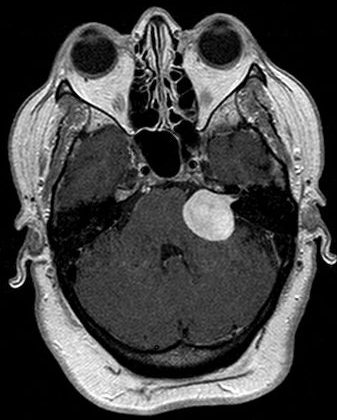
Dell ’ VIII cranial nerve Schwannoma (vestibulocochlear nerve), sometimes improperly called acoustic nerve neurinoma, is a benign tumor that arises from Schwann cells (Schwannoma).
Hits 7-10 subjects per million per year. Shows a slight preference for the female sex and the highest incidence in the 5th decade. Represents the 8-10% of intracranial tumors and 80% of cancers of the pontocerebellar angle. In most cases originates from the vestibular nerve component. And’ almost always unilateral in rare bilateral forms is frequently associated to Neurofibromatosis Type 2.
Can be located in the internal auditory canal, in ’ angolopontocerebellare or both.
Grows slowly, but can be reached by the time even the 4-5 cm. It is whitish, encapsulated bottom, growing up tends to become multi-cusped, coming out that can take mushroom shape.
There are two types: Antoni A and B, the first is characterized by numerous spindle cells, intertwined in bundles, the second from most fabric span, with fatty degeneration.
In most cases, is manifested by a progressive unilateral sensorineural hearing loss, often associated with tinnitus. Hearing loss affecting preferentially the treble, but can become chromatism (involve all frequencies); may be associated with imbalance and only rarely to vestibular disease. In 7-15% begins with a sudden hearing loss. In case of important dimensions can cause compression of the trunk, cerebellum and other cranial nerves (Faciale, neuralgia, the trochlear, oculomotor).
The diagnosis usually begins with an ENT evaluation that excludes other causes of sensorineural hearing loss and tinnitus, ensure the type of hearing loss with hearing test. To recognize a Schwannoma can be useful in the research of auditory evoked potentials (ABR) and vestibular disorders (VEMPS)
Diagnostic confirmation is done by nuclear magnetic resonance better if in contrast agent.
Schwannomas can be treated either surgically or with radiation therapy (gamma knife).
Both treatments see a high risk of exacerbating l ’ hearing loss or cause complete deafness (anacusia). As these benign masses and being absolutely rare malignant degeneration is appropriate to reassess the patient periodically with both hearing tests than with NMR before proposing a treatment.









